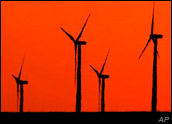
Researchers at Stanford University have used nanoparticles of copper hexacyanoferrate to create electrodes that could lead to large batteries for storing excess power from the electrical grid for future use.
These might be best used in wind and solar farms, the researchers stated in a paper published in a recent issue of Nature Communications.
The nanoparticles allow for faster charging and discharging of electricity and could allow the creation of low-cost large batteries that have a relatively long life.
“For years we’ve been looking for a viable way to store commercial volumes of energy, whether through compressed air, hydro pump systems or through whatever new technologies are out there,” Frank Maisano, an energy analyst at Bracewell Giuliani, told TechNewsWorld.
“The researchers are certainly trying to address the right parameters by focusing on technologies that can be low-cost, long-lived and highly efficient,” Haresh Kamath, program manager of energy storage at electric utility industry group the Electric Power Research Institute, told TechNewsWorld.
“The next step would be to show that the material would work in an electrochemical cell, and then to show that the cells can be made practically into a battery in the real world,” Kamath added.
Copper Hexawhat?
The Stanford researchers demonstrated that crystalline nanoparticles of copper hexacyanoferrate can work as a battery electrode in low-cost liquid electrolytes.
Copper hexacyanoferrate is an analog of Prussian Blue, a dark blue pigment used by artists, which goes by the chemical name “iron(III)-hexacyanoferrate(II).”
After 40,000 deep discharges at a 17 C rate, the crystals retained 83 percent of their original capacity.
The C rating is the maximum safe continuous discharge rate of a battery pack. A 10C rating, for example, means the battery pack can be discharged at 10 times its capacity as measured in milliamp-hours, or mAh.
A battery made with copper hexacyanoferrate technology would serve wind and solar power sources, which require stationary energy storage systems that can operate for many cycles at high power, with high round-trip energy efficiency at low cost, the researchers stated.
At modest current densities, the hexacyanoferrate crystals can achieve round-trip energy efficiencies of 99 percent, the researchers found.
Why Copperhexacyanoferrate?
Copper hexacyanoferrate crystals have an open framework that let an electrode charge or discharge without being damaged by letting ions move in and out of the electrode freely.
Ions are electrically charged particles.
This free movement makes for very rapid charging and discharging of the electrodes.
The researchers used hydrated potassium ions and a water-based electrolyte.
Worshipping the Sun and Wind
The availability of wind and solar power depends on the climate, and they have to be captured when available.
While these sources of energy are more environmentally friendly than traditional fossil power plants, they have a downside.
The output of traditional fossil power plants can be controlled by increasing or decreasing the flow of fuel, which lets operators manage the amount of power generated in response to demand, EPRI’s Kamath said.
However, wind and solar power is wasted when it’s throttled, Kamath pointed out. Further, when these energy sources aren’t available, other backup sources of power such as gas turbines must be used.
Low-cost, highly efficient energy storage would resolve this wastage problem, Kamath remarked.
To Research, Perchance to Dream
There’s just one problem with the copper hexacyanoferrate crystal electrode the Stanford researchers developed — it only provides half the equation for a new battery.
The electrode’s chemical composition means it can only be used as a high-voltage cathode. Batteries need a low-voltage anode as well as a high-voltage cathode
The researchers have begun investigating various materials for the anode. Until an anode is tested, however, things will remain up in the air.
“You’re looking at an uncertain technology that, while promising in the lab, may not be as practical on a commercial scale,” Bracewell’s Maisano stated.
“We’ve had some very promising [storage] technologies but the problem is, we haven’t been able to scale them up and have them work cost-effectively,” Maisano added.
Still, although it might take “a few years” to bring this copper hexacyanoferrate technology into the real world, “any advance in this area is potentially very exciting,” EPRI’s Kamath said.





















































